News
Holy land
Diocesan Lenten Pilgrimage to Holy Land, Feb/March 2009
“ Finding God in Holy Places”
The first half of our pilgrimage was mainly devoted to Jesus’ ministry
and daily life around the Sea of Galilee. We visited the Mount of the Beatitudes
at Tabgha where Jesus preached the Sermon on the Mount, the Church of the Multiplication
celebrating the Lord’s miracle of feeding the five thousand and Capernaum
from where Jesus based his Galilean ministry. At The Sanctuary of the Primacy
of St. Peter, commemorating Jesus’ appearance for the third time after
his resurrection to cook an early morning breakfast for his apostles on a rock
called Mensa Christi, we gathered for our first communion service
After lunch at a nearby Kibbutz, where we tasted the famous Tapila (St. Peter’s
fish), we stopped at Kursi (the land of the Gerasenes), where Jesus healed the
man possessed by demons, before driving back to Tiberias through the Valley of
Bethsaida.
On the first Sunday of Lent, after viewing the Baha’i Gardens, we visited
the Carmelite Monastery and the Grotto of the prophet Elijah on Mount Carmel.
In St. Luke’s Anglican Church in Haifa, we had the wonderful opportunity
to worship and celebrate Holy Communion with “the living stones”,
the Arabic Christians, descendants of those Christians who stayed in Israel,
following the Pentecost all those centuries ago. The rector there is Rev. Hatim,
whose mother-in-law is from the Clogher Diocese and, after a delicious lunch,
we visited Caesarea Maritima (originally built by Herod the Great) - the port
from which St Paul set out on three of his journeys and where Peter baptised
Cornelius the Centurion.
Another day we trekked along the River Dan, pausing by a tranquil pool to sing “As
the deer pants for the water”, to Dan Springs (the source of the River
Jordan) and on to Tel Dan, the site of the ancient Canaanite town of Laish/Leshem.
We drove along the Golan Heights to Caesarea Philippi which is remembered as
the site of Peter’s first primacy when he declared that Christ was the
longed for Messiah and Jesus replied “I will give you the keys of the Kingdom
of Heaven”. Later we drove through two Druze villages stopping to enjoy
a traditional Druze lunch in the foothills of Mt. Hermon.
At the Hula Swamp, we witnessed the ongoing battle between man and nature as
the thousands of migrating birds stop to feed on the crops on their way to and
from Africa and at Kibbutz Ginosar we saw the restored remains of a 2000 year
old fishing boat which had been discovered in the waters nearby after a period
of drought.
A highlight for many was the celebration of Holy Communion on the Sea of Galilee.
We travelled to Cana where Jesus performed his first miracle, turning water into
wine at the wedding and then on to Nazareth where Jesus spent 27 years of his
life and learned the trade of a carpenter. From Nazareth we travelled through
the Valley of Jezreel to Mt. Tabor – believed to be the Mount of the Transfiguration
- through Nain where Jesus raised the widow’s son from the dead and on
to the Yardenit Baptismal Site, on the River Jordan, where we each had the opportunity
to renew our own baptismal vows.
Leaving Galilee, we travelled through the wilderness of the Judean Desert, visiting
Jericho (purported to be the world’s oldest city). High up on The Mount
of Temptation, where the devil tried to tempt Jesus, we took Holy Communion and
sang “Forty Days and Forty Nights”. Outside Jericho, we saw the symbolic
Tree of Zacchaeus and then continued along the Syrian-African rift which stretches
for 6,500 kilometres, to the Dead Sea (the lowest point on Earth, 1290 ft. below
sea level). As we floated in the salt waters, just before sunset, we had time
to reflect on our journey from Galilee and how our leaders had led us in the
footsteps of Christ, carefully and with meaningful worship at all the important
sites, truly enabling us to find God in the Holy Places we had visited.
After leaving the Dead Sea we visited Masada where, in 73AD, 960 “Zealots” committed
mass suicide rather than surrender to the Romans. Our next stop was Qumran, where
the first Dead Sea Scrolls were discovered by Bedouin shepherds in 1947. Driving
through the Judean Desert we stopped to look out over the old Jericho to Jerusalem
road; the scene of the parable of the Good Samaritan.
Less than two miles from Jerusalem, in Bethany, we visited the Franciscan Church
of St. Lazarus built over the house of Mary, Martha and Lazarus followed by the
Tomb where Jesus raised Lazarus from the dead.
In Jerusalem we stayed at “The Olive Tree” hotel; a site which has
been a rest place for pilgrims since the time of King David.
The next day we explored nearby Bethlehem. In The Church of The Nativity, after
viewing the grotto where Jesus was born and the site of the Holy Manger, we had
a short service and sang “O Little Town of Bethlehem”. Nearby we
visited the Basilica of St. Catherine and the Cloister of St. Jerome which contains
his tomb and the graves of the innocent children killed by order of King Herod.
At the Shepherds’ fields, where shepherds received the news that a Saviour
had been born in Bethlehem, we had a reading and prayed in one of the caves.
Passing the newly completed fountain of the Good Shepherd we paused and, at this
uniquely fitting place, the Rev. Glenn West paid tribute to Bishop Michael Jackson
on the 7th anniversary of his consecration as Bishop of Clogher.
The next day began with prayer on the Mt. of Olives at the Franciscan Church
of Dominus Flevit (‘The Lord Wept’) which marks the area where the
Lord wept for Jerusalem on Palm Sunday. In the Garden of Gethsemane, where Jesus
often met with his disciples and where he was arrested, we prayed and visited
the Church of All Nations.
On Mt. Zion, we visited the Church of St. Peter in Gallicantu (Latin for ‘cock
crow’), the site of Peter’s denial. Next to the church we walked
up ancient steps, thought to be the original path Jesus would have followed from
Gethsemane to the house of the High Priest Caiaphas. There we prayed in the dungeon
into which Christ had to be lowered by a rope, his feet and hands bound.
As we solemnly followed the Via Dolorosa (Way of Sorrow), which marks the road
Jesus travelled as he carried the cross to the place of his crucifixion, at least
thirty members of the pilgrimage participated in the readings and prayers which
brought home to us the agony endured by our Lord on his final journey. When we
arrived at the Church of the Holy Sepulchre, which now stands over Golgotha (Calvary),
we witnessed three Lenten processions.
That night, our guide, Isaac, led us on a magical tour of Old and New Jerusalem.
We saw the illuminated walls of the Old City and The Knesset (Israeli parliament)
and drove through Mea-She’arim, home to a branch of Ultra-Orthodox Jews
who still live as their ancestors did in Eastern Europe centuries ago, without
newspapers, television or radio.
On our last day we explored the Temple Mount, famous as the place where Abraham
almost sacrificed his son Isaac and as the site of the 1st and 2nd Temple. Today,
on the Mount stands The Dome of the Rock (built above the rock from which Muslims
believe the prophet Muhammad ascended to Heaven) and the El Aqsa Mosque. We visited
the Western Wall also referred to as the Wailing Wall or the Wall of Tears. It
was a humbling experience to witness the Jewish people at worship in this sacred
place and we felt privileged to be allowed to approach and touch the wall in
reverence and prayer. Later, there was an opportunity to explore the newly excavated
West Wall Tunnels.
We retraced our steps to Mt. Zion to visit the Upper Room which, a few days previously,
had been closed. This was where Jesus celebrated The Last Supper and where the
disciples are thought to have gathered on the Day of Pentecost.
In the afternoon, we visited Yad Vashem, the Holocaust Memorial Museum whose
task is to preserve the memory and story of the 6 million Jewish victims for
future generations so that the world will never forget the horrors and cruelty
of the Holocaust.
On the way home some of us visited the Garden Tomb which is a quiet and sacred
spot for reflection and prayer.
The previous day, we had attended a service of Holy Communion in St George’s
Cathedral where our Bishop had been invited to preach the sermon. There we met
with Bishop Suheil Dawani and Canon Edmunds, who at the close of the service
asked us to do three things on our return to Ireland;
To talk of the people we had met and how God had touched our hearts; to pray
for the small Arab Christian community and to let people know how much their
financial support was appreciated.
After enjoying refreshments in the sunny cathedral courtyard, on taking leave
of our fellow Christians, we sang an “Irish Blessing”.
That afternoon, we returned to the Greek Catholic Patriarch Church, where some
of us had attended the Women’s World Day of Prayer, to learn about the
ceiling paintings and the icons. On leaving, Archimandrite Joseph, also, was
keen to leave us with a similar message to that we had heard from our Anglican
brothers and sisters – “Don’t just tell them you had a good
time in Jerusalem, tell them about the people you met…….but especially
tell them you met with the Risen Lord.”
We have seen places we have only dreamed about
We have seen places we have only read about
We have seen places we have only heard about
We have seen places we have only prayed about
Now we have walked into places where the footsteps of God are deep
And yet new to you and me
But God only asks one thing
For us to take one step with him now
(Contributors: Ethne, Hilda and Jenny)

St Luke's Anglican Church, Haifa
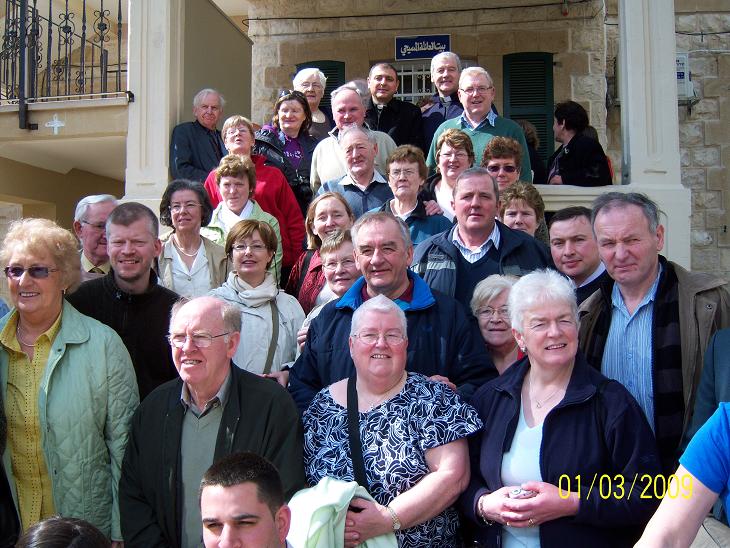
St Luke's Anglican Church, Haifa
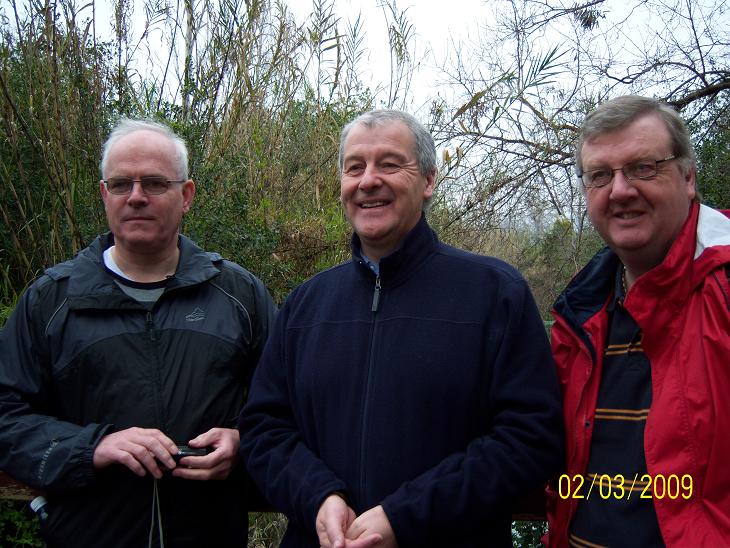
Rev David Skuce, Bishop Jackson and Rev Glenn West at River Dan
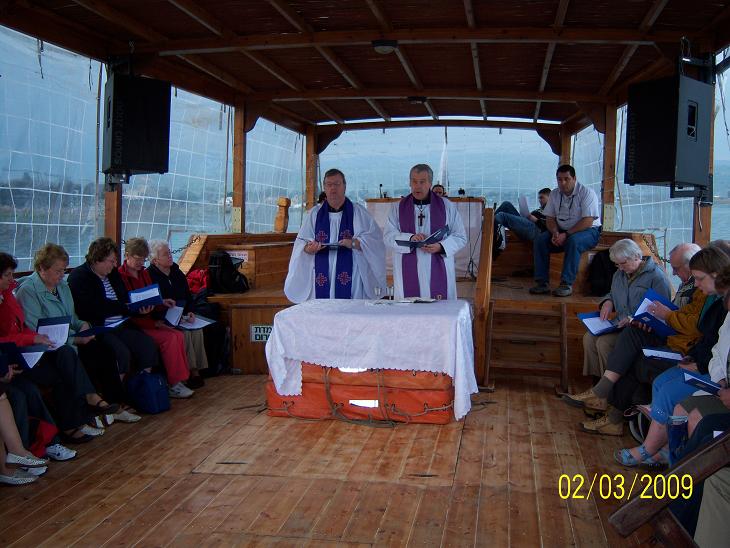
HC at the Sea of Galilee

Fountain of Good Shepherd, Bethlehem on Bishop Jacksons 7th Anniversary as
Bishop
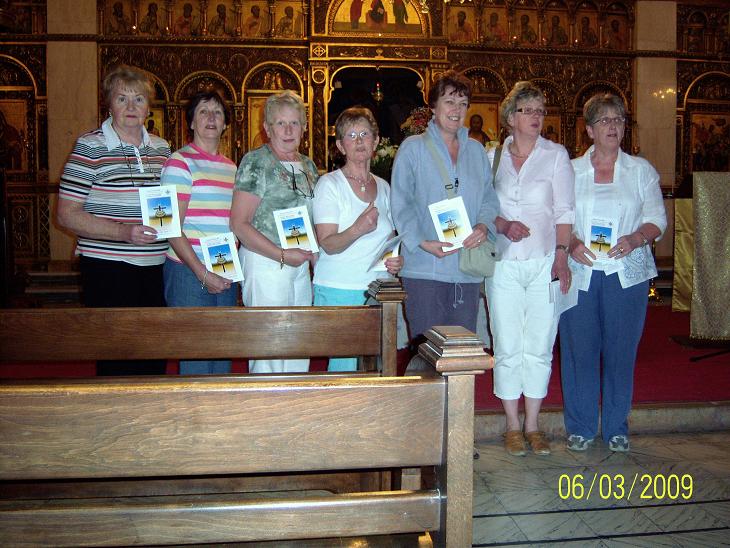
MU members at Womens World Day of Prayer in Jerusalem
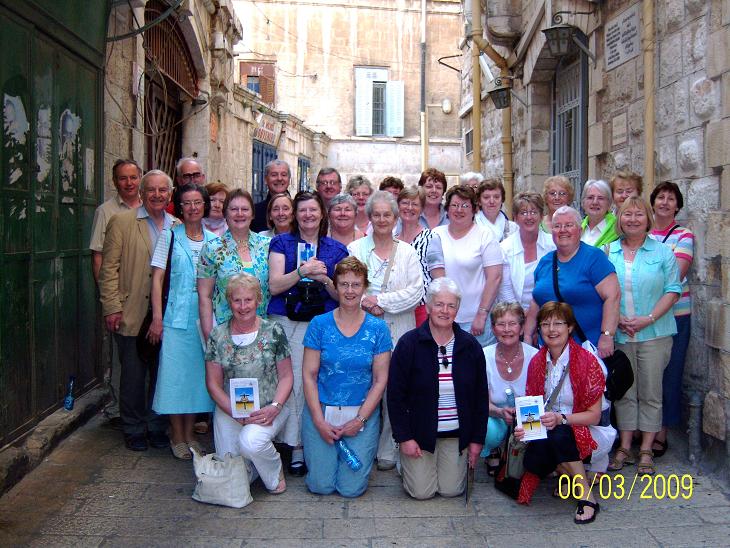
Group at Womens World Day of Prayer in Jerusalem

Bishops Jackson and Dawani at St Georges Cathedral, Jerusalem

Bishops Dawani and Jackson and Canon Robert Edmunds at St Georges Cathedral,
Jerusalem
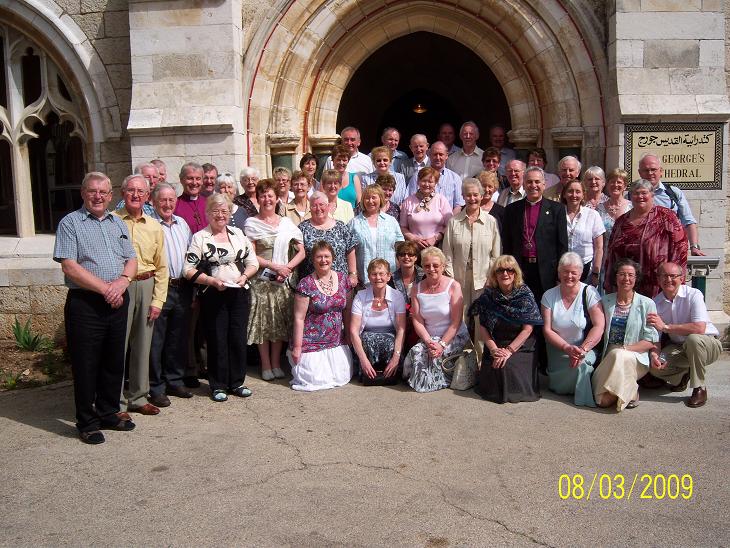
Group at at St Georges Cathedral,
Jerusalem
Date: March 2009
Photos provided by: Ethne & David McCord